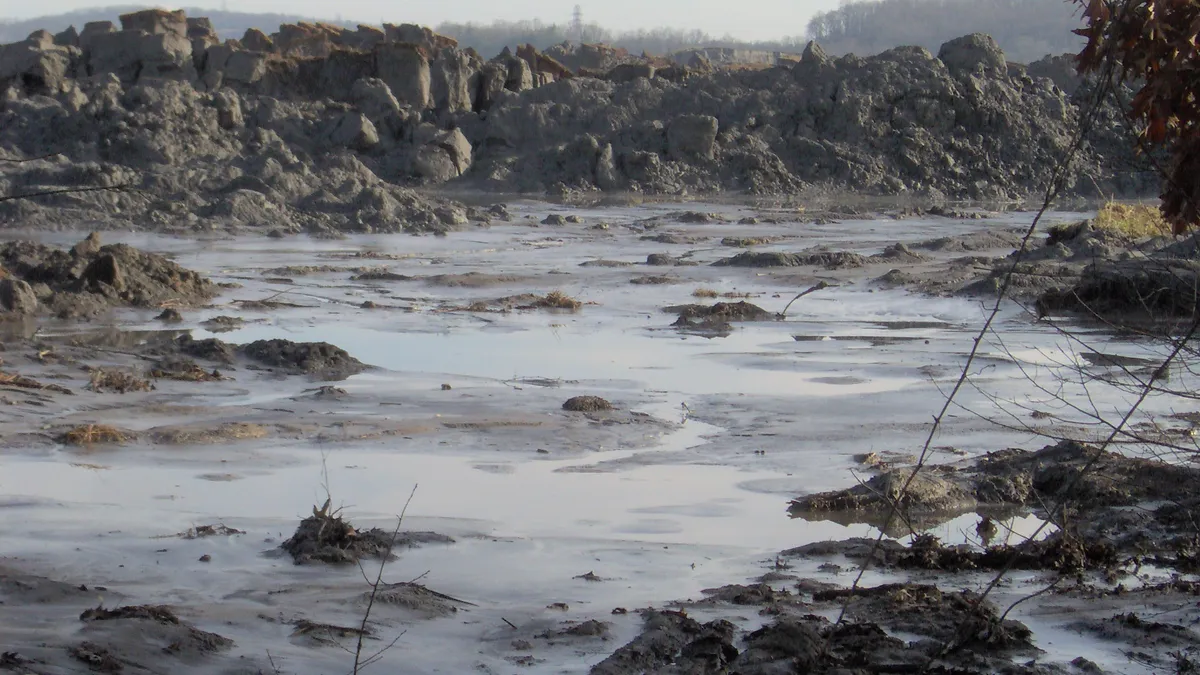Dive Brief:
- Groundwater is contaminated at 11 out of 12 Georgia coal plant sites, displaying unsafe levels of one or more pollutants, according to a report released Thursday by the Environmental Integrity Project (EIP) and Earthjustice.
-
A number of coal ash ponds being closed are violating requirements that waste not be in contact with groundwater, the report revealed. The environmental groups obtained data after a 2015 federal coal ash rule required utilities to make groundwater contamination information publicly available.
- 10 of those plant sites belong to Georgia Power, which is currently in the process of closing down its 29 coal ash ponds, with 19 slated for excavation and 10 to remain capped and in place. How to close those 10 ponds is the main point of contention between the utility and environmental groups, as the report says capping the ponds in place "is unlikely to stop contamination" and the utility says "advanced engineering methods" will ensure no further groundwater is contaminated.
Dive Insight:
As utilities move away from coal and begin to transition the way they store their coal waste, environmental groups are pushing for ash ponds to be fully excavated to avoid further pollution of the groundwater near former and operating coal plants.
The new report recommends the full excavation of all sites in contact with groundwater.
"What we're worried about is situations where the coal ash ponds are capped in place," Lisa Evans, senior counsel at Earthjustice and co-author of the report, told Utility Dive.
"These toxic ponds can be extremely large and tens of millions of tons of coal ash may remain in those ponds. And furthermore, the ponds may remain in contact with the underlying groundwater. So, if you simply leave ash in place when the ash is in contact with groundwater, the groundwater is going to stay in contact with the ash and is going to be flowing under the capped unit."
Georgia Power said the ponds it is not excavating are "located away from lakes and rivers" and they are using additional methods, "termed 'advanced engineering' methods," to prevent groundwater contact with the base of the pond "going forward," Aaron Mitchell, Georgia Power's general manager of environmental affairs, told Utility Dive.
Those methods include "consolidating the footprint" of the pond, or cutting down on its size. The utility's coal ash ponds hold millions of tons of ash, stretch hundreds of acres wide and dozens of feet deep. Another method is extending the cover system across the top of the ponds and installing "impermeable barriers" around the sides of the pond to prevent additional leakage, according to Mitchell.
However, the report also raises the concern that contaminants may be reaching drinking wells and waterways outside the facilities.
"The data show that those ponds are leaking chemicals at levels that are unsafe for human consumption," said Evans. So, "the testing of drinking water wells around that area is absolutely necessary to ensure protection of the communities that live close to the ponds."
Mitchell said the utility's groundwater data verifies that contamination "is isolated to our site," but Evans maintained a thorough testing of nearby surface water is necessary.
"Georgia Power may choose to say that these wells are all on the facilities' sites and that may be true," said Evans. "But that doesn't prove the negative, or prove that contamination hasn't traveled onsite and made the impact on drinking water wells or the health and safety of the streams and lakes."
Coal ash ponds require permitting under federal law and Georgia is the second state to apply to operate its own permit program, the EPA announced in June. The report recommends Georgia take a harder look at those permitting requirements, including required excavation of all ponds in contact with groundwater.
Earthjustice and the EIP have been going through the groundwater filings of utilities across the country since March and plan to release a report on countrywide contamination in January.
"One thing that's been interesting is the extent to which the leaking and the fact that [sites across the U.S are] leaking above health standards at 95% of the sites," said Evans. "That should be a warning bowel for EPA, for state governments and for communities, a real wake up call that more attention is needed to make sure that this contamination is not entering drinking water or aquatic systems."'














